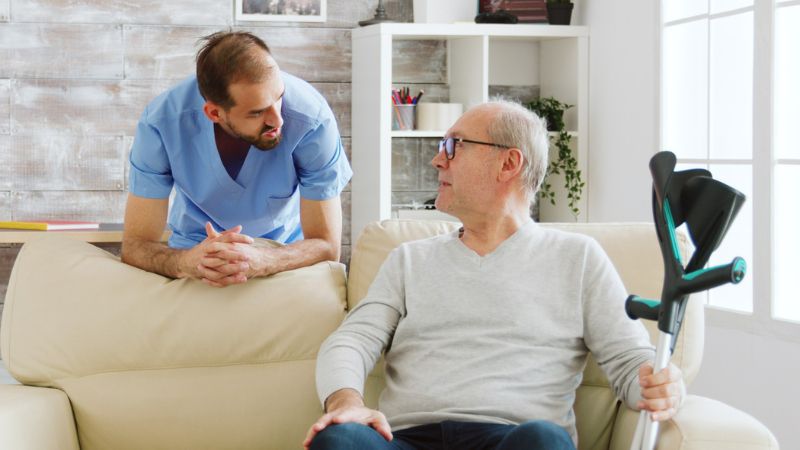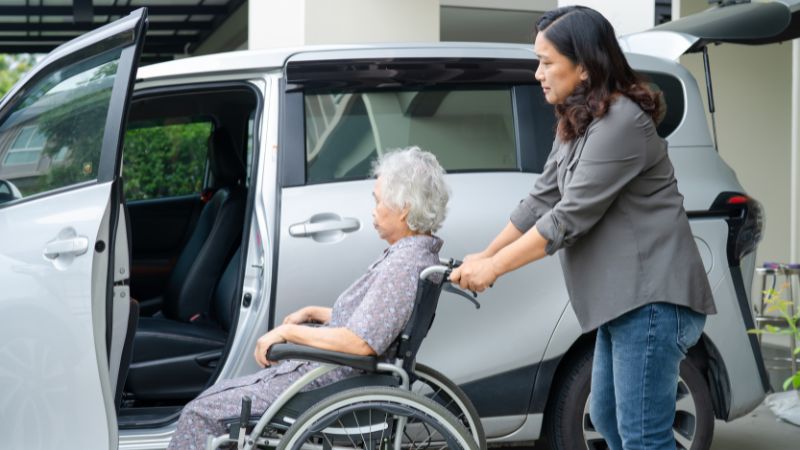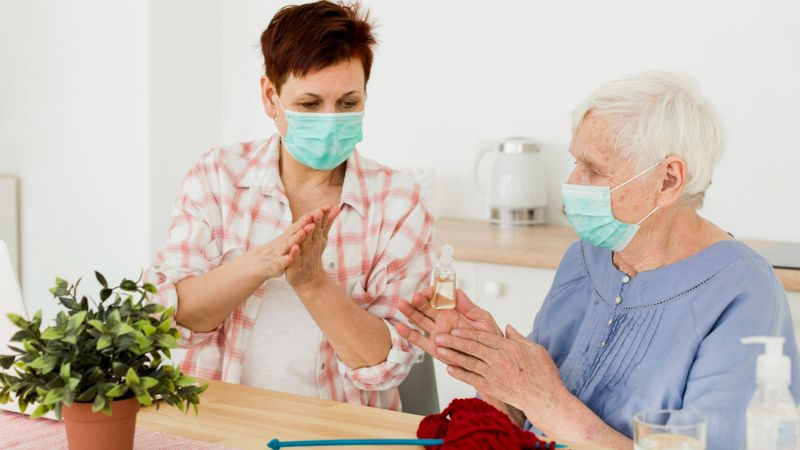For Caregivers
Empowering Caregivers: Navigating the CDPAP Program with Confidence

In the realm of homecare, the Consumer Directed Personal Assistance Program (CDPAP) stands as a beacon of empowerment for both patients and their caregivers. This unique program not only offers patients the opportunity to receive care in the comfort of their homes but also allows them to choose their caregivers. Often, these caregivers are family members, friends, or individuals personally known to them, transforming the caregiving experience into one that is deeply personal and tailored to the patient’s needs.
For caregivers, CDPAP offers an unparalleled opportunity to provide care while also receiving financial compensation. However, navigating the intricacies of the CDPAP program can be daunting. This blog aims to empower caregivers with the knowledge and confidence needed to navigate the CDPAP program effectively.
The Role of Caregivers in CDPAP
As a caregiver in the CDPAP program, you’re more than just a provider of care. You’re a critical component of your loved one’s well-being, offering not just physical support but emotional comfort as well. Your roles might include managing medication, assisting with daily living activities, and ensuring the home environment is safe and conducive to their health.
Getting Started with CDPAP:
Eligibility and Enrollment
The first step in navigating CDPAP confidently is understanding the eligibility requirements for both caregivers and consumers. Consumers must be eligible for Medicaid and require assistance with daily activities. Caregivers must be legally allowed to work in the U.S., and while most family members can become caregivers under CDPAP, spouses and designated representatives are typically ineligible.
The Application Process
Navigating the application process involves coordinating with a local social services department or a managed care organization (MCO). Documentation proving the consumer’s need for home care and the caregiver’s eligibility is crucial. Patience and persistence are key, as the process can be lengthy and complex.
Maximizing Your Role as a Caregiver:
Training and Development
While CDPAP does not require formal training for caregivers, taking the initiative to educate yourself on basic caregiving skills, emergency response, and the specific needs of the consumer can be incredibly beneficial. Resources are available through local health departments, online platforms, and community centers.
Legal and Financial Considerations
Understanding the legal and financial aspects of being a caregiver under CDPAP is vital. This includes knowing how to track hours, understanding the payment process, and recognizing the rights and responsibilities you have under the program.
Navigating Challenges
Caregiving, while rewarding, can present challenges. Emotional stress, physical demands, and navigating the bureaucracy of the CDPAP program can be overwhelming. Seeking support through caregiver support groups, counseling, or respite care services can help manage these challenges effectively.
Building a Supportive Community
One of the most empowering aspects of being a caregiver in the CDPAP program is the ability to connect with a community of individuals sharing similar experiences. Engaging with caregiver forums, participating in local support groups, and utilizing social media platforms can provide valuable insights, encouragement, and practical advice.
Navigating the CDPAP program with confidence is a journey of empowerment, learning, and growth for caregivers. By understanding the program’s nuances, maximizing your role through education and support, and building a community, you can provide exceptional care to your loved one while also finding fulfillment in your caregiving role. Remember, your efforts not only contribute to the well-being of the person you’re caring for but also pave the way for a more compassionate and personalized healthcare system.
CDPAP Essentials: A Caregiver’s Guide to Personalized Homecare

The Consumer Directed Personal Assistance Program (CDPAP) represents a significant shift from traditional homecare models, offering a more personalized and flexible approach to caregiving. This program allows individuals needing assistance with daily activities to choose and hire their caregivers, often leading to more meaningful and effective care. For caregivers, whether family members, friends, or others close to the consumer, CDPAP not only provides an opportunity to care for their loved ones but also to be compensated for their invaluable service. This guide aims to walk caregivers through the essentials of providing personalized homecare under the CDPAP framework.
Key Features:
Consumer Control: Consumers or their designated representatives manage all aspects of their care.
Flexible Caregiving: Caregivers can be almost anyone the consumer trusts, excluding legally responsible adults like spouses.
Compensation for Caregivers: Caregivers receive payment for their services, which acknowledges the vital work they do.
Becoming a CDPAP Caregiver:
Determine Eligibility
Both the consumer and the caregiver must meet certain eligibility requirements. The consumer must be a Medicaid recipient who needs help with daily living activities. Potential caregivers need to be legally allowed to work in the U.S., and they cannot be the spouse or the designated representative of the consumer.
The Application Process
The process involves coordinating with the consumer’s healthcare provider and a local CDPAP administering agency. It includes submitting documentation that verifies the consumer’s need for care and the caregiver’s eligibility.
Developing a Care Plan
Together with the consumer (and possibly a healthcare professional), caregivers should develop a personalized care plan. This plan outlines the consumer’s daily needs, health goals, and how the caregiver will assist in achieving them.
Providing Care Under CDPAP:
Personalized Care
As a CDPAP caregiver, you have the unique opportunity to tailor care specifically to the consumer’s needs and preferences. This personalized approach can include everything from daily routines to managing medications and coordinating with healthcare professionals.
Skills and Training
While formal training isn’t required under CDPAP, caregivers are encouraged to seek out resources to enhance their skills, especially in areas specific to the consumer’s needs. This can include first aid, managing chronic conditions, or mobility assistance techniques.
Managing Administrative Duties
Caregivers also take on some administrative responsibilities, such as tracking hours worked and coordinating with the CDPAP fiscal intermediary for payroll purposes. Staying organized and maintaining open communication with the consumer and the intermediary is crucial.
Navigating Challenges
Caregiving is rewarding but can also be challenging. Emotional and physical stress are common, as is managing the balance between caregiving and personal life. Seek support from other caregivers, professional resources, and community groups to navigate these challenges effectively.
The Importance of Self-Care
Caring for someone else requires you to be at your best. Prioritizing your well-being is not selfish but essential. Regular breaks, hobbies, and social activities can replenish your energy and resilience
Being a caregiver under the CDPAP program is a profoundly rewarding role that comes with its unique set of challenges and responsibilities. By understanding the essentials of the program, developing a personalized care plan, and taking care of your own well-being, you can provide compassionate, effective care that enhances the quality of life for the person you’re supporting. Remember, your work not only impacts the individual in your care but also contributes to a more personalized and caring healthcare system.
From Novice to Expert: Mastering CDPAP as a First-Time Caregiver

Entering the world of caregiving through the Consumer Directed Personal Assistance Program (CDPAP) can feel like navigating uncharted waters for many first-time caregivers. CDPAP, a Medicaid program, allows consumers requiring home care to choose their caregivers, often leading to family members or friends stepping into the role with little to no formal training. This transition can be overwhelming, yet incredibly rewarding. This guide aims to equip first-time caregivers with the knowledge and tools needed to master CDPAP, transforming from novices to confident, skilled caregivers.
Eligibility and Enrollment
To participate in CDPAP, the care receiver must be a Medicaid recipient eligible for home care services. As a prospective caregiver, you must be legally allowed to work in the U.S. However, spouses and designated representatives are typically ineligible to be hired through the program.
Transitioning to a Caregiver Role
Becoming a caregiver involves more than just meeting eligibility requirements; it’s about preparing yourself mentally, emotionally, and practically for the responsibilities ahead.
Building a Solid Foundation
Educate Yourself: Familiarize yourself with the basics of home care, including personal care, health monitoring, and emergency response. Free online resources, community workshops, and CDPAP training materials can be invaluable.
Develop a Care Plan: Work closely with the care receiver to outline their daily needs, preferences, and health goals. This personalized care plan will guide your activities and ensure the care you provide aligns with their desires.
Mastering the Administrative Side
Understand Your Responsibilities: Learn about the documentation required, how to track hours, and the process for getting paid through the program. Organizational skills are crucial for managing these tasks efficiently.
Stay Informed: Regulations and policies around CDPAP can change. Keep yourself updated by maintaining regular communication with the CDPAP provider or fiscal intermediary involved in your care arrangement.
Nurturing Your Skills
As you grow more comfortable in your role, continually seek opportunities to expand your caregiving skills.
Continuous Learning: Take advantage of advanced training opportunities and resources on specialized care needs, such as dealing with chronic conditions or mobility issues.
Networking: Connect with other CDPAP caregivers through online forums, social media groups, or local support groups. Sharing experiences and advice can be incredibly helpful.
Managing Challenges and Stress
Caregiving is fulfilling, but it can also be stressful. Balancing care duties with your personal life requires resilience and support.
Practice Self-Care: Ensure you’re taking time for yourself. Regular exercise, hobbies, and social outings are essential to prevent caregiver burnout.
Seek Support: Don’t hesitate to reach out for help when needed. Whether it’s arranging for respite care or consulting with healthcare professionals for advice, support is available.
Mastering CDPAP as a first-time caregiver is a journey of growth, learning, and profound satisfaction. By understanding the program, preparing for your role, continuously improving your skills, and managing the challenges, you can provide exceptional care that truly makes a difference in your loved one’s life. Remember, every expert was once a novice, and with dedication and support, you can navigate CDPAP with confidence and grace.
Managing Caregiving and Personal Life Through CDPAP

In the demanding world of caregiving, achieving a harmonious balance between caring for a loved one and maintaining personal well-being can feel like a high-wire act. The Consumer Directed Personal Assistance Program (CDPAP) offers a unique approach to home care, allowing individuals to select their caregivers, often leading to family members or friends stepping into this role.
While this arrangement fosters a deep sense of personal connection and trust, it also poses challenges in managing the dual responsibilities of caregiving and personal life. This article delves into strategies for navigating these challenges, ensuring that both caregivers and care receivers thrive under the CDPAP model.
The Challenge: Balancing Caregiving and Personal Life
Embarking on a caregiving journey through CDPAP can be both rewarding and demanding. Caregivers often find themselves juggling their responsibilities to their loved ones with their own needs and aspirations. The key to managing this delicate balance lies in adopting strategies that prioritize well-being and efficiency.
Set Clear Boundaries
Establishing boundaries is crucial in any caregiving relationship, even more so when the caregiver and care receiver have a pre-existing personal relationship. Define clear limits on your availability and the scope of care you can provide, and communicate these boundaries openly and respectfully.
Create a Structured Care Plan
A well-organized care plan outlines the daily, weekly, and monthly care tasks, helping to manage time effectively. Include the care receiver in this planning process to ensure their needs are met while also respecting your personal time and commitments.
Embrace Flexibility
While structure is essential, flexibility is equally important. Life is unpredictable, and the ability to adapt to changes or emergencies without sacrificing your personal needs is a valuable skill for any caregiver.
Leverage Support Networks
You don’t have to go it alone. Engage other family members, friends, or professional services in the caregiving process. Utilizing a network of support can alleviate the burden and provide opportunities for respite.
Prioritize Self-Care
Self-care is not selfish; it’s necessary. Ensure you’re setting aside time for activities that replenish your energy and bring you joy. Whether it’s a hobby, exercise, or social outings, these activities are vital for your mental and physical health.
Seek Professional Resources
Take advantage of the resources and training provided by CDPAP and other community organizations. Knowledge about caregiving techniques, stress management, and time management can enhance your efficiency and well-being.
Communicate Openly
Maintain open lines of communication with the care receiver and other stakeholders in the caregiving process. Discuss expectations, challenges, and changes in circumstances to find solutions that work for everyone involved.
Navigating the balancing act of caregiving and personal life through CDPAP is a journey filled with challenges, learning opportunities, and profound rewards. By establishing boundaries, embracing flexibility, leveraging support, prioritizing self-care, and communicating openly, caregivers can create a sustainable approach that honors their well-being alongside their commitment to providing care. Remember, caring for yourself is just as important as caring for others. Through thoughtful management and support, it’s possible to thrive in both your caregiving role and personal life.
Maximizing the Benefits of CDPAP for Caregivers and Consumers

The Consumer Directed Personal Assistance Program (CDPAP) stands out as a revolutionary approach in the landscape of home care, providing a platform where consumers have the autonomy to hire, direct, and manage their caregivers. This unique model not only empowers individuals needing care but also opens a gateway for caregivers to play a pivotal role in the well-being of their loved ones, often with the added benefit of financial compensation. However, navigating the CDPAP system and unlocking its full potential requires insight and strategy. Here, we share insider tips aimed at maximizing the benefits of CDPAP for both caregivers and consumers, ensuring a rewarding experience for all parties involved.
For Caregivers:
Understand the Program Inside and Out
Knowledge is power. Familiarize yourself with all aspects of CDPAP, including eligibility criteria, the enrollment process, and your rights and responsibilities as a caregiver. State departments of health and CDPAP fiscal intermediaries are valuable resources for comprehensive information.
Enhance Your Caregiving Skills
While CDPAP does not require formal training, possessing a strong skill set in caregiving can significantly enhance the quality of care you provide. Consider pursuing courses in basic medical care, emergency response, and specialized care tailored to the consumer’s specific needs.
Efficient Time Management
Caregiving is demanding, making time management a crucial skill. Create a structured schedule that includes time for caregiving tasks, personal errands, and rest. Utilizing tools like calendars or caregiving apps can help keep track of tasks and appointments.
Maintain Clear Communication
Effective communication with the consumer is fundamental in the CDPAP model. Regularly discuss care plans, expectations, and any changes in health status to ensure that care is responsive and tailored to their needs.
For Consumers
Choose the Right Caregiver
The success of CDPAP largely hinges on selecting the right caregiver. Choose someone who is not only trustworthy and reliable but also compatible with your personality and capable of meeting your specific care needs.
Develop a Collaborative Care Plan
Work closely with your caregiver to create a detailed care plan. This plan should outline daily routines, healthcare appointments, medication schedules, and any other specific care requirements, ensuring that both parties are clear on expectations.
Stay Informed About Your Rights
As a consumer, you have specific rights under CDPAP, including the right to hire, direct, and dismiss your caregiver. Understanding these rights helps you maintain control over your care and ensures a positive caregiving relationship.
Regularly Evaluate the Caregiving Arrangement
Periodically assess the effectiveness of the caregiving arrangement. This includes evaluating the quality of care received, the caregiver’s performance, and the overall impact on your quality of life. Open dialogue and flexibility to make changes as needed are key to maximizing the benefits of CDPAP.
Maximizing Mutual Benefits:
Leverage Support and Resources
Both caregivers and consumers should take advantage of available support and resources. This includes accessing training, joining support groups, and utilizing fiscal intermediary services for administrative assistance.
Foster a Positive Relationship
A strong, positive relationship between the caregiver and consumer is essential for a successful CDPAP experience. Mutual respect, understanding, and empathy go a long way in creating a supportive and effective care environment.
Prioritize Health and Well-being
Ultimately, the goal of CDPAP is to enhance the health and well-being of both the caregiver and consumer. This means prioritizing self-care for caregivers and ensuring that consumers receive the personalized care they need to live a fulfilling life.
The Consumer Directed Personal Assistance Program offers a unique opportunity for caregivers and consumers to collaborate in a personalized care setting. By understanding the program, leveraging available resources, and fostering a positive caregiving relationship, both parties can maximize the benefits of CDPAP. Remember, the key to a successful CDPAP experience lies in communication, education, and mutual respect, ensuring a rewarding journey for everyone involved.
Solutions for Common CDPAP Caregiver Obstacles

The Consumer Directed Personal Assistance Program (CDPAP) empowers individuals requiring care to choose and manage their caregivers, often leading to more personalized and effective home care experiences. While this program offers numerous benefits, caregivers may encounter specific challenges along the way. Understanding these obstacles and knowing how to navigate them is crucial for both the caregiver’s and consumer’s well-being. This blog explores common challenges faced by CDPAP caregivers and provides practical solutions to address them head-on.
Navigating the Administrative Process:
Solution: Educate and Prepare
The CDPAP administrative process, including paperwork and compliance with regulations, can be daunting. The best approach is to thoroughly educate yourself about the program’s requirements. Utilize resources provided by fiscal intermediaries, attend workshops, and seek advice from experienced caregivers. Staying organized and keeping meticulous records can also simplify the administrative burden.
Balancing Caregiving with Personal Life:
Solution: Set Clear Boundaries and Schedule Wisely
Maintaining a healthy balance between caregiving responsibilities and personal life is essential. Establish clear boundaries regarding your availability and communicate these openly with the care recipient. Use a calendar or scheduling app to plan caregiving tasks, personal commitments, and much-needed downtime, ensuring you don’t neglect your well-being.
Dealing with Emotional and Physical Stress:
Solution: Prioritize Self-Care and Seek Support
Caregiving can be both emotionally and physically taxing. Prioritize self-care by engaging in activities that rejuvenate your spirit and body, such as exercise, hobbies, or spending time with friends. Don’t hesitate to seek support from caregiver support groups or professional counseling services to manage stress and prevent burnout.
Ensuring Quality of Care:
Solution: Continual Learning and Collaboration
Providing high-quality care requires ongoing education and adaptation. Take advantage of training opportunities to enhance your caregiving skills. Collaborate with healthcare professionals to stay informed about the care recipient’s evolving needs. Regularly review and adjust the care plan in partnership with the consumer to ensure it remains effective.
Financial Management:
Solution: Financial Planning and Utilization of Resources
Managing finances, including understanding how payment through CDPAP works and budgeting for care-related expenses, can be challenging. Work closely with the fiscal intermediary to understand the financial aspects of the program. Utilize budgeting tools and apps to keep track of expenses and plan for future costs effectively.
Communication with Care Recipient:
Solution: Foster Open and Respectful Communication
Effective communication is the cornerstone of a successful caregiver-consumer relationship. Encourage regular discussions about care preferences, concerns, and any changes in health status. Be open, listen actively, and address any issues with empathy and respect to ensure mutual understanding and satisfaction.
Legal and Ethical Considerations:
Solution: Stay Informed and Ethical
Caregivers must navigate legal and ethical considerations, including respecting the consumer’s privacy and making informed care decisions. Stay informed about legal responsibilities and ethical guidelines through educational resources and professional advice. Always act in the best interest of the care recipient, maintaining their dignity and rights.
Being a CDPAP caregiver comes with its set of challenges, but with the right approach, these can be managed effectively. By educating yourself, setting clear boundaries, prioritizing self-care, engaging in continual learning, and fostering open communication, you can overcome obstacles and provide the best possible care. Remember, facing challenges head-on is not just about finding immediate solutions; it’s about building resilience and enhancing the caregiving experience for both you and the consumer.
7 Effective Strategies for Managing Stress as a CDPAP Caregiver

The role of a caregiver under the Consumer Directed Personal Assistance Program (CDPAP) can be immensely rewarding, as it empowers you to provide personalized care to loved ones who are either elderly or disabled. However, the responsibilities involved often lead to high-stress levels, which can affect your health and well-being. Managing this stress is not just beneficial—it’s essential. Here are seven practical strategies to help you maintain your peace of mind and deliver the best care to your loved ones.
1. Establish a Routine
Creating a structured daily schedule is a cornerstone of stress reduction. Routine lends predictability to your day, reducing the number and impact of unexpected challenges. Set specific times for medication, meals, exercise, and rest. This not only helps in organizing your day but also assures the person you’re caring for, as they can anticipate what’s coming next.
2. Leverage Support Networks
You don’t have to do it alone. Engage with community resources like local caregiver support groups or online forums. These platforms allow you to connect with peers who understand exactly what you’re going through. Sharing experiences and solutions can provide not just emotional comfort, but also practical advice on navigating caregiver challenges.
3. Practice Self-care
Prioritizing your health is crucial. Engage in activities that nourish your body and mind, such as yoga, meditation, or reading. Adequate sleep, a balanced diet, and regular physical activity can greatly improve your energy levels and mental sharpness, helping you cope better with daily stresses.
4. Educate Yourself
Knowledge is power. The more you know about your loved one’s condition, the more effective your caregiving will be. Utilize resources from healthcare providers or specialized organizations to stay informed about the medical aspects of their condition and the latest care strategies.
5. Set Boundaries
It’s important to recognize when to say no. Overextending yourself can lead to burnout. Clearly define what you are capable of handling and communicate this to family members and the person you care for. Setting realistic expectations helps manage both your stress and the stress of your loved one.
6. Use Respite Care
Taking regular breaks is vital. Respite care services provide temporary relief, offering you time to recharge. Whether it’s a few hours a week or a longer break, stepping back periodically allows you to return to caregiving with renewed focus and energy.
7. Seek Professional Help
If stress becomes overwhelming, consider seeking help from a mental health professional. Counseling or therapy can offer strategies to manage stress effectively and maintain emotional equilibrium.
Being a CDPAP caregiver is a significant role filled with challenges, but employing these strategies can make your caregiving journey less stressful and more rewarding. Remember, taking care of yourself is not an act of selfishness—it’s a necessity. By managing your stress, you are not only safeguarding your health but also enhancing the quality of care you provide.
5 Ways to Optimize Your Daily Routine with CDPAP

In the fast-paced world we live in, every minute counts. This is especially true for those caring for loved ones with chronic illnesses or disabilities. Fortunately, the Consumer Directed Personal Assistance Program (CDPAP) offers a unique way to manage care that is both empowering and flexible.
This program allows individuals to hire, train, and manage their caregivers—even if they are friends or family. Today, we’re diving into five practical ways you can optimize your daily routine using CDPAP, ensuring your loved one receives the best care while also maximizing your time and resources.
1. Customize Care to Meet Specific Needs
Every patient’s needs are unique, and the flexibility of CDPAP empowers you to tailor care specifically. Start by assessing the specific medical and personal needs of your loved one. For instance, if they require specialized attention due to conditions like multiple sclerosis, Alzheimer’s, or physical disabilities, you can customize their daily routine to include necessary medical tasks such as medication management, physical therapy, and personalized nutrition plans. This tailored approach not only enhances the quality of care but also improves the patient’s overall comfort and well-being.
2. Streamline Communication
Effective communication is key in any caregiving scenario. Under CDPAP, since the caregiver might already be someone personally close to the patient, establishing open lines of communication becomes easier and more effective. Utilize tools like caregiving apps or daily logs to maintain clear and consistent communication about health changes, doctor’s instructions, and daily needs. This ensures that everyone involved is up-to-date, making the care process more efficient and less susceptible to errors.
3. Leverage the Familiarity Advantage
One of the most significant benefits of CDPAP is the ability to have a caregiver who is not only familiar but also trusted by the patient. This familiarity can be a powerful tool in the caregiver’s arsenal, allowing them to detect subtle changes in the patient’s mood or health, anticipate needs, and provide comfort more effectively than someone who is not as intimately acquainted with the patient. This can lead to faster response times in emergencies and overall better daily management of the patient’s condition.
4. Implement a Robust Support System
While CDPAP facilitates one-on-one care, establishing a network of support is vital. Consider setting up a system where secondary caregivers can step in when the primary caregiver is unavailable. This could be through informal networks of other family members, friends, or even community health workers who can provide respite or supplementary care. Additionally, take advantage of local caregiver support groups and online resources to enhance your caregiving skills and emotional resilience.
5. Optimize the Care Environment
Finally, optimizing the physical environment of the patient can greatly enhance the efficiency of daily caregiving routines. Adapt your home to be more accessible and safe, which might include installing grab bars in the bathroom, arranging furniture to create clear pathways, or investing in assistive devices that promote independence for the patient. These modifications can help prevent accidents, reduce the physical strain on the caregiver, and boost the patient’s confidence in moving independently.
Through CDPAP, caregivers have a unique opportunity to provide personalized, compassionate, and effective care. By customizing the care experience, streamlining communication, leveraging close personal relationships, building a supportive network, and optimizing the care environment, you can significantly enhance the quality of life for both the caregiver and the recipient. Embrace these strategies to make your caregiving journey as rewarding and efficient as possible, ensuring your loved one not only receives care but thrives under it.
The Top 6 Resources for CDPAP Caregivers

Are you navigating the complexities of being a CDPAP caregiver? It’s a role that comes with big responsibilities: from medical management to emotional support, the spectrum of needs is broad and demanding. But fear not! The right tools and resources can make your caregiving journey not only more manageable but also more rewarding.
Whether you’re just starting or looking to enhance your caregiving skills, we’ve lined up the top six resources that are sure to be game-changers. These tools are tailored to help you provide compassionate and competent care, ensuring your loved one’s health and happiness without compromising your own.
The Top 6 Essential Resources for CDPAP Caregivers:
1. CDPAP Department of Health Website
Why It’s Essential: The official Department of Health website is a treasure trove of up-to-date information on the Consumer Directed Personal Assistance Program (CDPAP). This site provides crucial forms, policy updates, and procedural guides that are fundamental for compliance and efficient caregiving.
Best For: New caregivers who are navigating the CDPAP landscape for the first time.
2. Caregiver Support Groups
Why It’s Essential: Emotional and practical support is key to managing the stresses of caregiving. Online forums and local support groups offer a community of peers who understand the unique challenges you face. These groups can provide empathy, advice, and coping strategies that are invaluable.
Best For: Caregivers feeling isolated in their responsibilities and seeking emotional support or advice.
3. Home Health Technology Tools
Why It’s Essential: Technology can significantly ease the caregiving burden. From medication reminders to health monitoring apps, these tools help keep track of the health and wellness of the person you are caring for. They also streamline communication with health professionals and reduce the risk of medical errors.
Best For: Tech-savvy caregivers who want to leverage modern tools to enhance care quality.
4. Educational Workshops and Webinars
Why It’s Essential: Continuous learning is crucial in healthcare. Workshops and webinars provide essential training and updates on best practices in caregiving. These resources can help you enhance your skills in areas such as emergency preparedness, disease-specific care, and mental health management.
Best For: Caregivers looking to expand their knowledge and stay updated on healthcare trends and techniques.
5. Respite Care Services
Why It’s Essential: Every caregiver needs a break. Respite care services offer short-term substitutions that relieve caregivers, allowing them time to rest and recharge. This is crucial for maintaining your health, which in turn, benefits the person you’re caring for.
Best For: Caregivers who need temporary rest to prevent burnout.
6. Legal and Financial Advisory Services
Why It’s Essential: Navigating the legal and financial aspects of caregiving can be daunting. Professional advisors can offer guidance on matters like Medicaid planning, healthcare directives, and patient rights, ensuring that you’re making informed decisions that protect both you and your loved one.
Best For: Caregivers needing expert advice on complex administrative or legal tasks.
Stepping into the shoes of a CDPAP caregiver is no small feat. However, with these six essential resources, you can ease the burden and improve the care you provide. From leveraging state-of-the-art health tech to joining supportive communities, each resource offers a unique benefit that can help you become a more effective and fulfilled caregiver. Remember, taking advantage of these tools not only helps your loved one but also ensures that you can sustain this noble effort long-term. So dive in, explore these resources, and empower yourself to give the best care possible.
12 Common Challenges Faced by CDPAP Caregivers and How to Overcome Them

Caring for a loved one through the Consumer Directed Personal Assistance Program (CDPAP) can be deeply rewarding, providing an opportunity for personalized, compassionate care within the comfort of home. However, this path is not without its unique set of challenges. From managing the complex emotional landscape to navigating bureaucratic hurdles, CDPAP caregivers often find themselves in multifaceted roles that require patience, resilience, and a proactive mindset.
In this blog post, we will explore 12 common challenges faced by CDPAP caregivers and offer practical solutions to help them navigate these hurdles effectively, ensuring the best care for their loved ones while maintaining their health and well-being.
1. Complex Paperwork and Administration
Navigating the administrative maze of healthcare documentation, insurance, and CDPAP requirements can be daunting.
Solution: Utilize organizational tools such as digital document management systems and checklists. Regular consultations with healthcare advisors or experienced CDPAP coordinators can also provide clarity and guidance.
2. Lack of Formal Training
Many CDPAP caregivers are family members who may not have formal medical training, which can be stressful when medical tasks are required.
Solution: Seek out training opportunities provided by local healthcare organizations or online platforms. Knowledge about basic medical procedures, CPR, and emergency response can be invaluable.
3. Emotional Burnout
The emotional weight of caregiving, especially for a family member, can lead to burnout.
Solution: It’s crucial to manage stress through regular breaks, hobbies, or support groups. Emotional support can also come from counseling services or caregiver support networks.
4. Time Management Struggles
Balancing caregiving with other responsibilities such as work or personal life can create significant stress.
Solution: Develop a structured schedule that includes time for all responsibilities, and don’t hesitate to explore respite care options to give yourself necessary breaks.
5. Physical Demands
Caregiving can be physically demanding, leading to fatigue or injury.
Solution: Maintain a regimen of physical wellness that includes proper exercise, nutrition, and sleep. Learn proper techniques for physical tasks like lifting or transferring to prevent injuries.
6. Financial Strain
The cost of caregiving, including potential lost income and out-of-pocket expenses, can impact a caregiver’s financial stability.
Solution: Explore eligibility for financial support through CDPAP and other state or local programs. Budgeting tools and financial advice specific to healthcare can also be beneficial.
7. Navigating Healthcare Needs
Managing the healthcare needs of a patient, from medication management to doctor’s appointments, can be complex.
Solution: Establish a comprehensive care plan with healthcare providers that outlines all medical needs, schedules, and treatments. Use medication management systems to stay organized.
8. Isolation
Caregivers often experience social isolation due to their responsibilities.
Solution: Actively maintain social contacts and seek out community support groups or online forums where experiences and challenges can be shared with peers.
9. Lack of Recognition
Feeling undervalued can affect a caregiver’s morale and effectiveness.
Solution: Open communication with family members about the caregiving role can help in gaining recognition and support. Celebrate small victories and acknowledge the essential role you play.
10. Handling Emergencies
Unexpected medical emergencies can be overwhelming for untrained caregivers.
Solution: Familiarize yourself with emergency procedures and keep emergency contacts readily available. Regular reviews of emergency plans with healthcare professionals can also be helpful.
11. Dealing with Behavioral Issues
Patients may exhibit difficult behaviors due to their conditions.
Solution: Educational workshops on behavior management can be instrumental. Professional consultations with psychologists or specialized counselors can also provide strategies and support.
12. Maintaining Patient’s Dignity
Preserving the dignity and autonomy of the person being cared for is a priority that can sometimes be challenging to uphold.
Solution: Engage in open and respectful communication with your patient. Encourage their independence as much as possible and respect their privacy and choices.
While the journey of a CDPAP caregiver is filled with challenges, it is also one of profound connection and fulfillment. By preparing for and addressing these challenges head-on, caregivers can not only enhance their caregiving experience but also improve the quality of life for both themselves and their loved ones. Remember, you are not alone in this journey; resources and support networks are available to assist you every step of the way.
A Day in the Life of a CDPAP Caregiver

Imagine your alarm clock goes off at the crack of dawn. Instead of gearing up for a typical office day, you prepare yourself to make a substantial impact in someone’s life. For a CDPAP caregiver, every day is an opportunity to not just provide essential care but also to enhance the quality of life for a loved one, be it a family member or a close friend.
This role, facilitated by the Consumer Directed Personal Assistance Program (CDPAP), is unique in the healthcare field as it allows individuals to be cared for by someone they trust, rather than by a stranger. Let’s walk through a day in the life of a CDPAP caregiver to understand the profound and personal impact these caregivers have.
Morning Routine: Starting the Day with Care
6:30 AM – Rise and Shine:
The day begins early for the caregiver, often before the sun rises. After personal morning rituals, the caregiver’s first task is to check on the patient. This might involve assisting with basic hygiene, administering morning medications, and preparing breakfast tailored to specific dietary needs.
8:00 AM – Breakfast and Planning:
Mealtime is more than just feeding; it’s about ensuring nutritional balance and enjoying a moment of companionship. This time also serves as an opportunity to discuss the day’s plan with the patient, align on appointments, and set mutual goals.
Midday Activities: Medical Management and Companionship
10:00 AM – Health Monitoring and Exercise:
Routine health checks are crucial. The caregiver might record vital signs and manage medical equipment, if necessary. This is followed by light exercise, which could include a short walk or physiotherapy exercises, depending on the patient’s health condition.
12:00 PM – Lunch and Leisure:
Preparing a lunch that adheres to the patient’s health requirements is next. Post-lunch often includes leisure activities that both can enjoy, such as reading, watching a favorite TV show, or simply chatting. This helps in keeping the patient mentally active and emotionally engaged.
Afternoon Responsibilities: Personal Care and Errands
2:00 PM – Personal Care Tasks:
Afternoons are reserved for personal care, perhaps assisting the patient with bathing or managing personal hygiene. These tasks are performed with dignity and respect, ensuring the patient feels comfortable and supported.
3:30 PM – Errands and Appointments:
The caregiver might run errands, such as grocery shopping or picking up medications. If there are medical appointments, the caregiver ensures transportation is arranged and accompanies the patient, providing necessary support throughout the visit.
Evening Wind-Down: Preparation for Night and Reflection
6:00 PM – Dinner Preparation and Reflection:
Evening meals are an essential end to the day’s dietary needs. Post-dinner, the caregiver and patient might reflect on the day, discussing any issues or special moments they shared, reinforcing their bond and understanding.
8:00 PM – Nighttime Routine:
As the day winds down, the caregiver helps the patient with the nighttime routine, which might include medication management and preparing for bed. Ensuring the patient is safe and comfortable for the night is the final task.
The Rewards of Personal Caregiving
Being a CDPAP caregiver is undoubtedly challenging, but it offers profound personal rewards. This role allows caregivers to provide not just clinical support but also emotional and moral support, making a significant difference in the lives of those they care for. Each day is filled with moments of personal connection, challenges overcome, and the satisfaction of knowing you are providing not just care, but comfort, dignity, and companionship.
This inside look at the daily life of a CDPAP caregiver shows the seamless blend of healthcare professionalism and heartfelt personal care. It’s a testament to the importance of empathy, respect, and commitment in the world of caregiving. If you or someone you know is considering a caregiving role through CDPAP, remember that the journey is as rewarding as it is demanding, filled with moments of love, challenge, and profound fulfillment.
Why CDPAP Is a Game-Changer for Caregivers

Imagine a healthcare program that prioritizes patients’ comfort and needs and empowers the individuals providing the care. The Consumer Directed Personal Assistance Program (CDPAP) does exactly that, redefining traditional caregiving roles and making it a personal affair.
This innovative approach is transforming the caregiving landscape, placing power directly in the hands of those who give and receive care. In this blog post, we’ll dive deep into why CDPAP is a true game-changer in the world of healthcare, offering a fresh perspective on personal care.
Empowering Personal Choice
Freedom to Choose:
One of the hallmark features of CDPAP is the empowerment it offers to patients. The program acknowledges the importance of a personal connection and trust in the caregiving process by allowing patients to select their caregivers. This choice not only enhances the comfort level of the patient but also improves the quality of care, as caregivers are personally motivated to do their best.
Enhanced Flexibility in Care
Customizable Schedules and Duties:
Unlike traditional home care setups where agencies rigidly define schedules and specific duties, CDPAP affords revolutionary flexibility. Caregivers can adjust their working hours and care routines to suit the specific needs and preferences of the patients, fostering an environment where care is truly responsive and adaptive.
Financial Benefits for Caregivers
Economic Incentives:
CDPAP also financially compensates individuals who undertake caregiving tasks, acknowledging the hard work and dedication involved in caring for a loved one. This not only helps alleviate the economic strain often associated with caregiving but also legitimizes it as a valuable and professional service.
Strengthening Family Bonds
Care Within the Family:
By enabling family members to become paid caregivers, CDPAP strengthens family bonds. This program supports the idea that the best care can come from within the family, allowing for a level of empathy, understanding, and patience that is hard to replicate by external caregivers.
Professional Support Without the Bureaucracy
Less Red Tape:
CDPAP caregivers are freed from the typical bureaucratic constraints that can stifle the caregiving process in traditional settings. Without the need to adhere to stringent agency regulations, caregivers can focus more on the immediate needs of the patient, providing care that is both intuitive and immediate.
The Transformative Impact of CDPAP
CDPAP is not just a program—it’s a movement towards more personalized, compassionate, and satisfying healthcare. It acknowledges the complexity and significance of caregiving and repositions it as a respected and essential service. Through its focus on choice, flexibility, and personal empowerment, CDPAP has indeed become a game-changer in the realm of caregiving. It provides a promising model for the future, where the quality of care is measured not only by the health outcomes of the patients but also by the quality of their daily lives and the satisfaction of their caregivers.
Embracing CDPAP can lead to a more fulfilling, compassionate, and tailored caregiving experience. For anyone considering this path, whether you are a patient or a potential caregiver, CDPAP offers an opportunity to redefine what it means to care for and be cared for. Explore how this program might change your life or the life of someone you love—it could be the game-changer you’ve been looking for.
The Realities of Being a CDPAP Caregiver: The Good, The Bad, and The Uplifting

When the conversation turns to caregiving, the imagery is often that of serene moments and grateful smiles. However, the reality is a mosaic of emotional highs and lows, logistical challenges, and ultimately, profound personal fulfillment. In the unique role of a CDPAP caregiver, where caregivers are often family members or close friends of the patient, these dynamics are even more pronounced.
This blog post aims to provide an honest exploration of the good, the bad, and the uplifting aspects of being a CDPAP caregiver, offering an insider’s view into the complexities of this essential service.
The Good: Personal Empowerment and Emotional Rewards
Empowering Personal Connections:
The Consumer Directed Personal Assistance Program (CDPAP) empowers patients to choose their caregivers, which often leads to family members stepping into these roles. This setup fosters a caregiving environment rooted in deep personal connections and trust, leading to more personalized and attentive care. Caregivers have the unique advantage of already understanding their patient’s preferences, needs, and personalities, which can significantly enhance the care experience.
Financial Compensation:
Unlike informal caregiving, which is often uncompensated, CDPAP acknowledges the hard work and dedication of caregivers by offering financial compensation. This not only helps ease the financial burden often associated with caregiving but also validates it as a professional and valuable service.
The Bad: Emotional and Physical Demands
Emotional Strain:
Being a caregiver, especially to someone you love, can be emotionally taxing. Watching a loved one struggle with health issues can bring about feelings of sadness, frustration, and helplessness, which are challenging to manage. This emotional labor is often underestimated and can impact a caregiver’s mental health.
Physical Exhaustion:
The demands of caregiving—ranging from physical tasks like bathing and lifting to the mental load of medical management—can be exhausting. Without proper support and respite, caregivers can experience burnout, which affects their ability to care effectively.
The Uplifting: The Rewards of Compassionate Care
Strengthening Bonds:
Despite the challenges, many caregivers report that their role has strengthened their relationships. Sharing in the day-to-day challenges and victories creates an unparalleled bond. This deeper connection can be incredibly fulfilling, knowing you have made a significant positive impact on the quality of life for someone important to you.
Sense of Purpose and Achievement:
There is a profound sense of accomplishment and purpose in being able to care for someone. This can be particularly poignant in a CDPAP setting, where the care provided is not just a job but a labor of love. Caregivers often express immense pride in their ability to manage complex care needs and in the visible benefits their care provides to their loved ones.
Embracing the Full Spectrum of Caregiving:
Being a CDPAP caregiver is no small feat. It involves a complex blend of personal sacrifice and professional responsibility. However, for many, the personal rewards of enhancing a loved one’s quality of life outweigh the hardships. By understanding and acknowledging both the challenges and the rewards, caregivers can better prepare for what lies ahead and find greater satisfaction in their critical role.
The journey of a CDPAP caregiver is filled with challenges, but it is also marked by moments of joy and profound connection. If you are considering a caregiving role or are already navigating this path, remember that while the road may be tough, the rewards can be deeply uplifting. As you consider this role, lean on available resources, seek support when needed, and cherish the uniquely rewarding experience that CDPAP caregiving offers.
How CDPAP is Redefining Home Care for the Better

In a world where healthcare often seems impersonal and standardized, the Consumer Directed Personal Assistance Program (CDPAP) stands out as a beacon of change, offering a more personalized and empowering approach to home care.
This innovative program not only reshapes how care is delivered but also enriches the lives of both caregivers and care recipients by fostering a deeper connection and understanding. Let’s delve into how CDPAP is redefining home care, making it not just a service, but a heartfelt exchange between loved ones.
The Shift Towards Personalized Care
Tailored Care Plans: Under CDPAP, the care regimen is designed by those who know the patient best. This level of personal input ensures that care plans are not only medically adequate but also culturally and personally resonant, aligning with the patient’s lifestyle and values. This customization is a significant shift from traditional home care models, which often apply a one-size-fits-all approach to care.
Enhancing Patient Autonomy
Empowering Patients: One of the most significant advantages of CDPAP is the empowerment it provides to patients. Being able to choose who cares for them and how they are cared for helps patients feel more in control of their lives and care processes. This autonomy can lead to improved patient satisfaction, better health outcomes, and a higher quality of life.
Economic Benefits
Cost-Effectiveness: CDPAP not only improves care quality but also offers a cost-effective solution to home care. By eliminating the need for intermediary agencies, the program reduces administrative overheads and directs more resources to direct caregiving activities. This not only makes CDPAP an economically viable option but also ensures that funds are utilized where they are needed most— in the actual provision of care.
Strengthening Family Bonds
Caring Within the Family: When caregivers are family members or friends, they bring an intrinsic understanding and emotional connection to their role. This can dramatically enhance the caregiving experience for both parties. The familiarity and trust built within these relationships help alleviate the stress and anxiety often associated with receiving care from strangers.
A Future of Compassionate Care
The Consumer Directed Personal Assistance Program is more than just a healthcare initiative; it is a forward-thinking approach to caregiving that acknowledges the importance of individuality, familiarity, and respect in the healing process. As CDPAP continues to redefine home care, it paves the way for a future where healthcare is not only about treating symptoms but also about nurturing the human spirit through compassionate, personalized care.
As we look toward the future of home care, the principles of CDPAP offer a hopeful vision of what healthcare can become: more humane, responsive, and respectful of the needs and wishes of those it aims to serve. Whether you are considering CDPAP for yourself or a loved one, embracing this model can lead to not just better care, but a better overall quality of life.
Is CDPAP the Best Option for Your Family? A Caregiver’s Insight

When a loved one needs care, the weight of decision-making can feel overwhelming. You’re not just choosing services; you’re entrusting someone’s well-being to another’s hands. In this high-stakes arena, the Consumer Directed Personal Assistance Program (CDPAP) presents a unique option.
This program allows individuals to recruit, hire, and direct their caregivers—be they family members or friends. But is CDPAP the best choice for your family? Let’s dive deep into the heart of CDPAP through the eyes of a caregiver, unraveling the layers to see if it truly fits your family’s needs.
Who Can Benefit from CDPAP?
CDPAP is designed for individuals who require assistance with daily activities such as bathing, dressing, cooking, and medical tasks. Ideal candidates are those who prefer a familiar face to assist them and who require consistent, possibly complex, medical care that can be managed at home. It’s particularly appealing for those who value the comfort and trust that comes with receiving care from known caregivers.
Advantages of CDPAP
- Familiarity and Comfort: Having a caregiver who is a loved family member or a close friend can reduce stress and promote a more comforting environment.
- Flexibility: Unlike traditional home care setups, CDPAP allows beneficiaries to set schedules that work best for them and their caregivers.
- Empowerment and Independence: Patients have significant control over their care, including who provides it and how it is administered.
- Potential for Better Care: Familiar caregivers might be more invested in the patient’s well-being and provide more attentive and personalized care.
Considerations Before Choosing CDPAP
While CDPAP offers many benefits, there are factors to consider:
- Administrative Responsibilities: Beneficiaries manage their care, including handling payroll and tax obligations for their caregivers.
- Eligibility Requirements: The patient must qualify for Medicaid, and the caregiver must legally be allowed to work in the U.S.
- Training Needs: Some medical tasks require specific knowledge or skills that not all potential caregivers will have initially.
Caregiver Insights on CDPAP
To provide a rounded view, we spoke to several caregivers currently participating in CDPAP. Their experiences underscore the program’s transformative potential but also highlight its challenges, particularly around the administrative workload and the emotional dynamics of caring for a family member full-time.
Is CDPAP Right for You?
Determining if CDPAP is the best choice involves assessing both the patient’s and the family’s needs and capacities. Here are some points to consider:
- Does the potential caregiver have the ability and willingness to learn necessary medical tasks?
- Can your family manage the administrative duties that come with directing your care?
- Is there a family member or friend you trust enough to take on this role?
Choosing the right care path for a loved one is a deeply personal decision that depends on multiple factors unique to each situation. CDPAP offers a compelling choice for those who prefer a hands-on approach to their care arrangements. By empowering patients with choice and familiarity, it represents a paradigm shift in how we think about caregiving. However, it demands careful consideration of the responsibilities and emotional roles involved.
How Can Caregivers Maintain a Healthy Work-Life Balance?

In the noble quest to provide compassionate and comprehensive care, caregivers under the Consumer Directed Personal Assistance Program (CDPAP) often face the daunting challenge of juggling their professional responsibilities with their personal lives. The nature of caregiving can be both rewarding and exhausting, deeply fulfilling yet sometimes overwhelming.
As they dedicate themselves to assisting others, CDPAP caregivers must not overlook their well-being. Achieving a healthy work-life balance is not just beneficial but essential for caregivers to maintain their health and continue providing the best care to those who depend on them.
Understanding the Stresses of CDPAP Caregiving
CDPAP caregivers perform a vital role in the healthcare ecosystem, providing critical support to individuals with disabilities, chronic illnesses, or age-related issues. This type of care requires a profound emotional and physical commitment, as caregivers often assist with daily living activities, medical tasks, and emotional support. The intimate nature of their work can lead to what healthcare professionals refer to as “caregiver burnout,” which is characterized by fatigue, stress, and decreased mental health.
Strategies for Maintaining Work-Life Balance
Set Clear Boundaries:
Establishing clear boundaries is crucial for mental health. Caregivers should define their working hours and ensure they are respected by clients and their families. This includes having set times when they are off duty and unavailable for caregiving responsibilities, allowing for uninterrupted personal time.
Prioritize Self-Care:
Caregivers should integrate self-care routines into their daily schedules. Regular physical activities, such as yoga or walking, can significantly reduce stress. Eating a balanced diet and getting enough sleep are also essential for maintaining energy levels and overall health.
Seek Professional Support:
Engaging with professionals like therapists or counselors who specialize in caregiver stress can provide valuable coping strategies. Many healthcare providers now offer telehealth services, making it easier for caregivers to access support from their homes or during breaks in their caregiving schedule.
Leverage Community Resources:
Many communities have resources designed specifically for caregivers. These might include support groups, respite care services, or educational workshops that can provide practical advice and emotional support.
Use Technology to Your Advantage:
Digital tools can streamline caregiving tasks, such as scheduling, medication management, and health monitoring, reducing the workload and stress for caregivers. Apps and health management systems can also help in maintaining accurate records and communication with healthcare professionals.
Communicate Openly:
Open communication with the care recipient and their family can help manage expectations and clarify the caregiver’s roles and limits. This is essential to prevent misunderstandings and to ensure that the caregiver’s needs are also respected.
Plan for Downtime:
Caregivers need to schedule downtime to pursue hobbies, social activities, or simply relax. This can prevent burnout and promote a healthier, more sustainable work-life balance.
Maintaining a healthy work-life balance is critical for CDPAP caregivers to sustain their physical and mental health. By setting boundaries, prioritizing self-care, and using available resources, caregivers can find a balance that allows them to provide compassionate care while also fulfilling their personal needs. Remember, taking care of yourself is not an act of selfishness—it is a necessity. Embracing these strategies can lead to a more rewarding and enduring caregiving experience.
What Are the Financial Benefits of Being a CDPAP Caregiver?

Becoming a CDPAP caregiver isn’t just about providing care; it’s about embracing a role that offers significant financial benefits. From earning a stable income to enjoying job flexibility, discover the monetary perks that this caregiving path provides.
Have you ever considered that being a caregiver could also mean becoming financially empowered?
With the CDPAP, caregivers are finding that this role offers more than just emotional rewards—it comes with tangible financial benefits. This innovative program allows individuals to care for their loved ones while receiving compensation that reflects the vital services they provide. Dive into the financial perks of being a CDPAP caregiver and see how this role could be the key to balancing personal satisfaction with economic stability.
Understanding the CDPAP Model
The CDPAP is a Medicaid program that grants patients the freedom to choose their caregivers, who can be family members, friends, or acquaintances. This model not only demystifies the caregiving experience but also redefines it by financially acknowledging the efforts of those who perform this critical role. Unlike traditional home care settings, caregivers under CDPAP are paid for their services, making caregiving a viable and respected profession.
Key Financial Benefits of Being a CDPAP Caregiver
Compensation for Caregiving
One of the most direct financial benefits is the ability to earn a steady income. Caregivers are compensated at a competitive rate, which is often on par with professional home health aides in their region. This remuneration is not only a paycheck; it’s a recognition of the invaluable support caregivers provide.
Flexibility and Increased Earning Potential
The flexibility inherent in CDPAP caregiving roles allows caregivers to set their schedules. This can enable caregivers to optimize their hours to suit their lifestyle or to manage multiple clients, potentially increasing their overall earnings. Such flexibility is rare in more traditional job markets, particularly in healthcare.
No Professional Certification Required
Unlike other caregiving roles that require formal certifications, CDPAP caregivers need not undergo professional training. This opens the door for many who wish to enter the caregiving field but are deterred by the cost and time associated with certification courses. Avoiding these expenses can be a significant financial relief.
Employment Benefits
Depending on the specific agency handling the CDPAP administration, caregivers might also receive employment benefits such as health insurance, paid leave, and other job-related perks. These benefits are critical for the long-term financial and personal well-being of caregivers.
Tax Benefits
Caregivers employed under CDPAP are considered full employees, not independent contractors, which means they benefit from certain tax deductions related to employment. Additionally, being employed can improve a caregiver’s qualifications for other financial benefits such as credits and retirement plans.
Emotional and Economic Stability
Providing care through CDPAP can offer a more stable employment situation compared to other part-time or gig economy jobs. This stability can translate into better financial planning and security, reducing the stress often associated with irregular income streams.
Being a CDPAP caregiver is not just a labor of love—it is a financially smart choice. This role provides economic empowerment and stability, offering caregivers compensation, flexibility, and benefits that are often lacking in other caregiving environments. Whether you’re looking to transition into a caregiving role or seeking a more financially rewarding path, CDPAP offers a unique opportunity to enhance your quality of life and financial health.
Embrace the chance to make a difference in your loved one’s life while securing your financial future. The journey of a CDPAP caregiver is one where professional fulfillment and financial benefits go hand in hand, making it a compelling choice for those eligible to participate.
How to Navigate the Challenges of a Caregiver's Responsibilities?

Embarking on a journey as a CDPAP caregiver is akin to steering a ship through both calm waters and unexpected storms. This vital role within the healthcare framework allows individuals to provide personalized care to loved ones while facing unique challenges that can test their resilience and adaptability.
Whether you’re tending to a family member with a chronic illness or assisting a friend with daily needs, understanding how to effectively navigate these responsibilities is crucial for maintaining both your well-being and that of your care recipient. Let’s explore how you can manage these challenges effectively, making your caregiving journey as smooth as possible.
Understanding CDPAP Caregiver Responsibilities
The Consumer Directed Personal Assistance Program (CDPAP) enables individuals needing care to appoint caregivers of their choice, including family members who may not have formal medical training. This model emphasizes patient comfort and trust but places significant responsibility on the caregiver. From medical management to personal care, the scope of duties is extensive.
Key Challenges and Strategies to Overcome Them
Emotional and Physical Stress
Implement a self-care routine. Regular exercise, adequate rest, and balanced nutrition are crucial. Consider mindfulness exercises or yoga to manage stress effectively. It’s important to recognize signs of burnout and seek support through caregiver support groups or professional counseling if needed.
Balancing Personal and Professional Life
Create a clear schedule that delineates time for caregiving and personal commitments. Use organizational tools like digital calendars to manage your time effectively. Communicating openly with family members about your availability can also help set realistic expectations.
Navigating Healthcare Needs Without Formal Training
Take advantage of resources offered by local hospitals, nonprofit organizations, or online platforms that provide training for medical tasks such as medication management, the use of medical equipment, and basic emergency responses. Building a relationship with the care recipient’s healthcare providers can also provide a backup for complex medical questions.
Financial Management
Understanding the financial aspects of caregiving is essential. If you’re managing your loved one’s finances along with their health, seek advice from financial advisors or utilize resources like financial management workshops tailored for caregivers. Ensure you’re fully aware of the compensation and benefits associated with CDPAP.
Legal and Ethical Decisions
Familiarize yourself with the legal responsibilities involved in caregiving. Consulting a lawyer who specializes in elder law or disability rights can guide how to make decisions that are in the best interest of the person you’re caring for while adhering to legal standards.
Navigating the responsibilities of a CDPAP caregiver demands resilience, patience, and resourcefulness. By embracing structured strategies and seeking out the necessary resources and support, caregivers can not only meet these challenges but also find profound satisfaction in their role. Remember, the key to managing caregiving duties effectively lies in recognizing the need for balance—between caring for others and caring for yourself. As you continue on this rewarding path, let these strategies guide you toward a fulfilling experience that upholds the dignity and comfort of your care recipient and nurtures your well-being.
What Support Systems Are Essential for CDPAP Caregivers?

As a caregiver under the Consumer Directed Personal Assistance Program (CDPAP), you are not just a helper but a cornerstone in the daily life of someone who requires care. The responsibility is great, and the role you play is crucial—not only for the health and well-being of your care recipient but for their overall quality of life. In this blog, we’ll explore the key support systems that are vital for you, the caregiver, to maintain both your effectiveness and your well-being.
Educational Resources and Training
First and foremost, caregivers need comprehensive training and ongoing education. Understanding the specific medical conditions and needs of your care recipient is essential. Look for programs offering certifications in CPR, first aid, and other critical care skills. Additionally, having access to resources about the latest caregiving techniques and medical care standards can significantly enhance the care you provide.
Emotional and Psychological Support
Caregiving is an emotionally taxing job that can lead to caregiver burnout if proper measures are not taken. Access to mental health support, such as counseling services or support groups, can provide a safe space to express and manage your feelings. These resources help in coping with the stress and emotional burden that can come from caregiving responsibilities.
Financial and Legal Assistance
Navigating the financial and legal aspects of caregiving can be overwhelming. From understanding health insurance policies to managing reimbursement processes under CDPAP, caregivers need clear guidance. Legal advice may also be necessary, especially when managing the legal rights of your care recipient. Support from financial advisors and legal experts can protect both you and the individual you care for.
Peer Networks
Connecting with other caregivers can be incredibly beneficial. Peer support networks offer the chance to share experiences, advice, and support. These networks can be found through local community centers, online platforms, and social media groups. They provide a community of understanding and can offer practical tips and emotional support that only those in similar situations can provide.
Respite Care Services
To prevent burnout, respite care is crucial. These services provide temporary relief for caregivers, allowing them time to rest and recharge. Whether it’s for a few hours or a few days, ensuring you have time to look after your health is as important as caring for others. Check for local respite care providers who can offer competent and reliable care when you need a break.
Technology and Tools
Leverage technology to make caregiving more manageable. Use digital tools and apps designed to track health metrics, medication schedules, and appointments. These can help streamline the caregiving process, making it less stressful and more efficient. Additionally, consider technologies like emergency response systems and mobility aids, which can enhance the safety and independence of the person you care for.
Navigating the Journey Together
Being a CDPAP caregiver is a profound commitment, and having the right support systems in place is essential for your success and well-being. By equipping yourself with the right tools and knowledge, connecting with others who understand your experiences, and ensuring you have access to mental and physical respite, you can make this journey a fulfilling one.
By taking care of both, you ensure the best possible care for your loved one and a more rewarding experience for yourself. Let’s navigate this journey together, with the right support every step of the way.
Building a Support Network: A Framework for CDPAP Caregivers

The path of a caregiver is often filled with rewarding moments and substantial challenges. When you are part of the Consumer Directed Personal Assistance Program (CDPAP), these highs and lows can be even more pronounced, as you manage the comprehensive care of a loved one with health issues. This vital role not only requires medical knowledge and patience but also a robust support network to sustain you through tough times. In this article, we’ll outline a practical framework for CDPAP caregivers to build a supportive community that enhances their caregiving capabilities and nurtures their well-being.
Understanding the Role of a CDPAP Caregiver
As a CDPAP caregiver, you are typically a family member or a friend who has stepped into a caregiving role, empowered to administer a wide range of medical and personal care tasks. From administering medication to managing daily activities, the role is complex and deeply integral to the patient’s quality of life. Given this substantial responsibility, having a solid support system is not just helpful—it’s essential.
Identify Your Needs
The first step in building a support network is to identify what kinds of support you need. These can include:
Emotional Support: To help manage the stress and emotional ups and downs of caregiving.
Practical Help: Assistance with household tasks, errands, or caregiving duties.
Professional Advice: Access to healthcare professionals or consultants who can offer guidance on medical and legal matters.
Educational Resources: Training and information that help you provide the best care possible.
Utilize Existing Resources
Many caregivers overlook resources that are readily available to them. Begin by researching local CDPAP coordinators, healthcare providers, and community centers that offer resources for caregivers. Libraries, hospitals, and senior centers often have programs or can connect you to networks that specialize in caregiver support. Utilize online platforms that offer forums, webinars, and articles focused on caregiving.
Connect with Peers
Building relationships with other caregivers can provide a sense of community and mutual understanding that is hard to find elsewhere. Look for support groups and online communities where experiences and resources can be shared. Platforms like Facebook, Meetup, or specific caregiver websites can connect you with peers. Regular meetings—whether virtual or in-person—can provide a consistent source of support and advice.
Establish Professional Contacts
Having a direct line to professionals can be invaluable. This might include doctors, nurses, social workers, and legal advisors who understand the specifics of CDPAP. They can offer expert advice and help navigate the complex medical and legal landscape associated with caregiving. Building these relationships can also streamline the process of managing care plans and medical emergencies.
Engage with Local Community Services
Many communities offer services that can be of great help to caregivers. These may include respite care, which allows caregivers to take breaks; transportation services for medical appointments; and meal delivery services. Local non-profits or religious organizations often provide additional support such as counseling or temporary financial aid for those in need.
Embrace Technology
Incorporate technology to ease the burden of caregiving. Various apps and tools can help manage medication schedules, doctor’s appointments, and daily caregiving tasks. Technologies like personal health record systems and remote monitoring devices can also enhance the care you provide while giving you peace of mind.
Creating Your Caregiving Circle
By following these steps, you can build a comprehensive support network that sustains you through the complexities of caregiving. Each element of your network—from peers and professionals to community resources and technology—plays a crucial role in enriching your caregiving journey and ensuring your well-being.
Remember, being a CDPAP caregiver is a significant role that you don’t have to navigate alone. With the right support network, you can find balance and joy in your caregiving role, all while providing compassionate and competent care to your loved one.
The Essential Skills Framework for CDPAP Caregivers

Becoming a caregiver through the Consumer Directed Personal Assistance Program (CDPAP) is a profound transition. It’s a role that allows you to deeply connect with and support a loved one in need, transforming the landscape of their everyday life.
But to thrive in this position, certain fundamental skills are critical. Whether you’re caring for a parent, spouse, friend, or another family member, mastering a set of core competencies can make your caregiving journey more effective and fulfilling. In this blog, we will explore the essential skills framework every CDPAP caregiver should develop.
Clinical Competence
Medical Knowledge: Understanding your care recipient’s basic health conditions and medical needs is paramount. This includes knowledge of their specific ailments, such as diabetes, heart disease, or mobility restrictions, and how they affect daily life.
Skill in Medical Tasks: Depending on the health needs of the individual, you might need to perform tasks like wound care, administering injections, or operating medical equipment like ventilators or dialysis machines. Proficiency in these tasks is crucial for maintaining the health and safety of the care recipient.
Communication Skills
Effective Dialogue: Clear and compassionate communication with the person you care for is essential. This involves not only speaking but listening to their concerns and responding to them thoughtfully.
Coordination with Healthcare Professionals: As a CDPAP caregiver, you will often need to interact with doctors, nurses, and other medical professionals. Being able to effectively communicate the needs of your care recipient and understand medical advice is vital.
Advocacy Abilities
Understanding Rights and Resources: Knowing both your rights and those of your care recipient under CDPAP can help you advocate more effectively. This includes understanding insurance coverages and accessing available healthcare services.
Standing up for Care Needs: Sometimes, you will need to be the voice for the care recipient, ensuring they receive the necessary treatments and interventions. This might involve challenging decisions or requesting further medical evaluations.
Emotional Intelligence
Empathy: Understanding and sharing the feelings of another is a cornerstone of effective caregiving. This empathy helps in providing compassionate care that respects the dignity of the care recipient.
Stress Management: Caregiving can be emotionally taxing. Being able to manage your stress and maintain emotional stability is crucial for both you and the person you are caring for.
Problem-Solving Skills
Crisis Management: In emergencies, the ability to stay calm and effective is essential. This could range from handling a fall to responding to a medical emergency.
Adaptability: The needs of your care recipient may change over time. Being able to adapt your caregiving strategies to meet these evolving needs is key to continued care success.
Time Management and Organization
Routine Development: Establishing and maintaining a daily routine helps in managing caregiving tasks without becoming overwhelmed. This includes medication schedules, doctors’ appointments, and personal care routines.
Record Keeping: Accurate and detailed record-keeping is vital in managing the health care of your loved one. This includes tracking medications, doctor’s appointments, dietary restrictions, and other critical health information.
Building Your Caregiving Competence
By developing these essential skills, CDPAP caregivers can provide better care, navigate the challenges of their roles more effectively, and enhance the quality of life for those they look after. Caregiving is a skill that grows with experience and continued learning. Take advantage of resources such as workshops, online courses, and caregiver support groups to enhance your abilities. The journey is demanding, but with the right skills, it can also be incredibly rewarding. Equip yourself with these competencies, and you will be prepared to meet the challenges of caregiving head-on, ensuring both you and your loved one thrive.
Planning Long-Term Care: A CDPAP Framework for Caregivers

Going on the journey of long-term caregiving through the Consumer Directed Personal Assistance Program (CDPAP) can feel a great deal like stepping into such a complex labyrinth, complete with rewarding passages and intimidating dead ends. It requires more than just goodwill; it demands careful planning, profound commitment, and a structured approach.
Understanding how to plan effectively is not a benefit but a point that is indispensable for those stepping into the role of a caregiver. Here, we explore a comprehensive framework to guide CDPAP caregivers in planning long-term care efficiently.
The Basics of CDPAP
Before diving into the planning process, it’s crucial to have a firm grasp of what CDPAP entails. This program allows individuals needing medical or personal care to choose their caregivers, who can even be family members. These caregivers are then compensated, which distinguishes CDPAP from more traditional caregiving roles. Understanding the regulations, benefits, and responsibilities under CDPAP will help you navigate the system more effectively and make informed decisions.
Comprehensive Needs Assessment
Identifying Care Needs: The first step in planning is to assess the medical, physical, and emotional needs of the care recipient. This involves understanding their daily living activities, medical routines, dietary needs, and any specific therapies or treatments they require. A thorough needs assessment helps in creating a tailored care plan that addresses all aspects of the recipient’s health and well-being.
Resources Inventory: Evaluate what resources are currently available and what additional support might be needed, including medical equipment, home modifications, and personal assistance.
Setting Realistic Goals
Short-term and Long-term Goals: With a clear understanding of the needs, the next step is to set achievable goals. These can be divided into short-term goals (such as improving mobility or managing a health condition better) and long-term goals (like maintaining a high quality of life or staying out of the hospital).
Measurable Outcomes: Ensure these goals are specific, measurable, achievable, relevant, and time-bound (SMART). This clarity will help in monitoring progress and making adjustments as needed.
Creating a Care Plan
Detailed Care Schedule: Develop a detailed plan that includes daily routines, medication timetables, exercise, and any other regular activities. A well-structured plan helps prevent caregiver burnout and ensures that the care recipient’s needs are met consistently.
Involvement of Care Team: If the caregiving responsibilities are shared among multiple people, such as family members or hired professionals, clearly define roles and responsibilities. Everyone involved should understand their tasks and how they fit into the larger plan.
Legal and Financial Planning
Insurance and Benefits: Navigate the maze of insurance, benefits, and other financial resources. Understand how to optimize the use of Medicare, Medicaid, or private insurance and ensure that all potential benefits are being utilized.
Legal Documents: Ensure all necessary legal documentation is in place. This includes power of attorney, medical directives, and any other relevant legal forms that support the wishes and rights of the care recipient.
Implementing Support Systems
Emotional Support: Caregiving can be isolating. Establish a support system that includes family, friends, and community resources. Consider joining support groups where experiences and strategies can be shared.
Professional Help: Don’t hesitate to reach out for professional help when necessary. This can include medical professionals, caregiving consultants, and mental health experts.
Regular Reviews and Adjustments
Monitor and Adapt: Regularly review the care plan to ensure it meets the evolving needs of the care recipient. Be flexible and ready to make changes as their health conditions and needs change over time.
The Path Forward
Planning long-term care under CDPAP is a dynamic and ongoing process. By establishing a clear, structured approach, caregivers can not only provide compassionate and competent care but also ensure their well-being. This journey, while challenging, is deeply rewarding, and with the right framework, you can navigate it with confidence and grace, ensuring a quality life for those you care for.
Navigating Legal Landscapes: What Every CDPAP Caregiver Needs to Know

Embarking on a journey as a CDPAP caregiver is not just about providing care—it’s about stepping into a world where compassion meets compliance. The Consumer Directed Personal Assistance Program (CDPAP) empowers individuals to manage their care by hiring caregivers of their choice, often family members or friends.
But what does this mean for you, the caregiver? From legal responsibilities to everyday tasks, the role comes with its own set of rules and regulations that can seem as intricate as they are intimidating. In this article, we’ll unpack the essentials of the CDPAP legal landscape, helping you not only fulfill your role effectively but also ensure you’re up to speed with the legalities that govern your duties.
Your Legal Role as a CDPAP Caregiver
Employment Status and Compliance
As a CDPAP caregiver, you’re not just a family member or a friend; you’re an employee of the consumer or their designated representative. This status brings with it specific compliance requirements:
- Labor Laws: You must adhere to state labor laws, which cover minimum wage, overtime, and working hours.
- Tax Obligations: Understanding your tax obligations is crucial. You will need to manage taxes differently than other types of employment, especially if you’re considered a household employee.
Confidentiality and Privacy
Adhering to HIPAA (Health Insurance Portability and Accountability Act) laws is essential:
- Patient Privacy: Ensure all medical information remains confidential unless disclosure is legally required or authorized by the patient.
- Security Practices: Implement secure practices for handling sensitive health information, whether digital or on paper.
Navigating Patient Care and Autonomy
Patient Rights and Autonomy
A core tenet of the CDPAP is patient autonomy:
- Decision Making: Patients have the right to make decisions regarding their health care, including the choice and dismissal of caregivers.
- Care Standards: Despite the informal hiring process, the standard of care must remain professional and attentive.
Documentation and Record Keeping
Accurate record-keeping is a non-negotiable part of the job:
- Time Sheets and Logs: Maintain detailed logs of hours worked, care provided, and any significant patient interactions.
- Health Records: Keep up-to-date health records as required by the program guidelines.
Ethical Considerations and Best Practices
Ethical Conduct
Maintaining ethical conduct is paramount:
- Respect and Dignity: Treat the patient with respect and dignity at all times.
- Conflict Resolution: Be prepared to handle conflicts sensitively, respecting the patient’s wishes and legal guidelines.
Continuing Education
Stay informed about changes in healthcare regulations and CDPAP-specific rules:
- Training and Resources: Regularly engage in training sessions and consult resources offered by healthcare authorities and CDPAP administrators.
Navigating the legal landscape of the CDPAP can seem daunting, but with the right knowledge and tools, you can excel in providing compassionate and compliant care. Remember, you’re not just a caregiver—you’re a vital advocate and ally in your patient’s healthcare journey. Stay informed, stay compliant, and above all, provide your patients with the dignity and care they deserve.
Effective Communication Skills for CDPAP Caregivers

Imagine you’re stepping into the world of caregiving, armed with a mission to not only provide physical support but also to foster a deep, empathetic connection with those you care for. In the realm of CDPAP, where caregivers are often family members or friends chosen by the patients themselves, the art of communication transcends traditional boundaries. It’s not just about delivering care, but about building trust, understanding needs without words, and creating a comforting presence that reassures your loved ones they are in safe hands.
In this blog, we’ll dive into the nuances of effective communication that every CDPAP caregiver needs to master. From active listening to clear conveyance of health instructions, these skills are essential tools in your caregiving toolkit. Whether you’re a seasoned professional or stepping into the shoes of a caregiver for the first time, this guide will equip you with the knowledge to enhance your caregiving journey, making every interaction more meaningful and professional.
Why Is Effective Communication Paramount in CDPAP?
Consumer Directed Personal Assistance Program (CDPAP) is a unique model of care that empowers consumers to hire and direct their caregivers—be they family members, friends, or acquaintances. This flexibility allows for a more personalized and comfortable caregiving environment but also places a greater emphasis on communication. Here’s why effective communication is not just beneficial but essential in CDPAP:
- Enhanced Care Coordination: Clear communication ensures that all aspects of the patient’s care plan are understood and executed properly, reducing errors and improving health outcomes.
- Emotional Support: Caregivers are often a primary source of emotional support. Open and empathetic communication helps in recognizing and addressing the psychological needs of patients.
- Increased Patient Engagement: When patients are involved in their care conversations, they are more likely to be engaged in their treatment plans, leading to better health management.
- Building Trust: Effective communication fosters trust, which is crucial when the caregiver is also a loved one or a close friend.
Key Communication Skills for CDPAP Caregivers
Here are some vital communication skills that every caregiver in the CDPAP program should develop:
- Active Listening: Focus on understanding the patient’s verbal and non-verbal messages. This involves not only hearing their words but also paying attention to tone and body language.
- Clear and Concise Communication: Use simple, clear language when discussing health care plans or medications. Avoid medical jargon unless necessary, and always check to ensure the patient understands.
- Patience and Empathy: Caregiving can be stressful, and patients may sometimes have difficulty expressing their needs. Showing patience and empathy can help ease their frustration and foster a more open dialogue.
- Feedback Encouragement: Actively encourage feedback to ensure that the patient feels their concerns and suggestions are valued and taken seriously.
- Conflict Resolution: Be prepared to handle disagreements or misunderstandings calmly and professionally, without letting personal feelings get in the way.
Practical Tips for Implementing Effective Communication
- Use of Technological Aids: Employ tools such as care management apps or simple calendars to keep track of medical appointments, medication schedules, and other important health-related activities.
- Regular Meetings: Set up regular check-ins with your patient and, if applicable, their family members to discuss progress, changes in health status, and any concerns.
- Documentation: Keep detailed records of all communications regarding health care plans and any changes made over time. This not only helps in maintaining continuity of care but also in legal compliance.
- Education and Training: Stay informed about the latest in healthcare guidelines and communication strategies through workshops and training sessions.
Mastering the art of communication is not just about talking and listening—it’s about connecting on a deeper level with the person under your care. For CDPAP caregivers, where the caregiver-patient relationship is often personal, these skills are particularly crucial. By enhancing your communication capabilities, you not only improve the care you provide but also enrich the lives of those you’re supporting. Take these tips, apply them daily, and watch as your caregiving transforms into an even more rewarding, professional, and compassionate journey.
Advanced Medical Support: Utilizing Technological Innovations to Improve CDPAP Healthcare Services

Imagine a world where your healthcare is not just a routine visit to a doctor, but a comprehensive, technologically empowered experience tailored to your specific needs. This is not a glimpse into a distant future but the reality of today’s Consumer Directed Personal Assistance Program (CDPAP).
Technological innovations are setting new standards in how care is delivered, managed, and optimized. This blog post dives into the fascinating integration of technology in CDPAP healthcare services, showcasing how these advancements are not just enhancing operational efficiency but also boosting patient care quality.
The Role of Technology in CDPAP:
Electronic Visit Verification (EVV) Systems
What It Is: EVV systems are used to ensure that care services are verified in terms of time and attendance. This technology helps in preventing fraud and ensuring that patients receive specified and scheduled care.
Benefits: Improves transparency and accountability in caregiving processes.
Telehealth and Remote Monitoring
What It Is: Utilizing digital information and communication technologies, like computers and mobile devices, to access health care services remotely and manage your health care. These may include consults via video calls, remote patient monitoring, and mobile health applications.
Benefits: Increases accessibility to expert consultations, reduces the need for frequent hospital visits, and allows for continuous monitoring of patient health metrics outside of traditional settings.
Data Analytics and AI
What It Is: Artificial intelligence and big data analytics are becoming a backbone for predictive healthcare, risk assessment, and management in the CDPAP landscape.
Benefits: Enhances decision-making processes, optimizes healthcare delivery, and personalizes patient care plans based on predictive models.
Integrated Care Platforms
What It Is: These are comprehensive software solutions that integrate various aspects of healthcare management including scheduling, billing, and patient records into a unified platform.
Benefits: Simplifies the administrative burdens, enhances care coordination, and improves the overall efficiency of healthcare services.
Impacts of Technological Advancements in CDPAP
The integration of technology into CDPAP not only streamlines processes but also significantly improves the quality of care. For instance, remote monitoring technologies have made it possible for patients to enjoy the comfort of their homes without compromising on quality or frequency of care. This is particularly beneficial for those with chronic conditions or disabilities, where frequent trips to the hospital can be taxing both physically and emotionally.
Challenges and Considerations
Despite the advantages, the implementation of technology in CDPAP comes with its set of challenges. Issues such as data privacy, high costs of initial setup, and the need for ongoing training of personnel must be addressed to fully realize the benefits of these technological innovations.
As we move forward, the role of technology in healthcare, especially in programs like CDPAP, is only set to increase. By embracing these innovations, CDPAP can provide more personalized, efficient, and higher-quality care, transforming the lives of many who rely on these essential services. As we look to the future, the potential of technology to further revolutionize this field is immense and full of possibilities.
